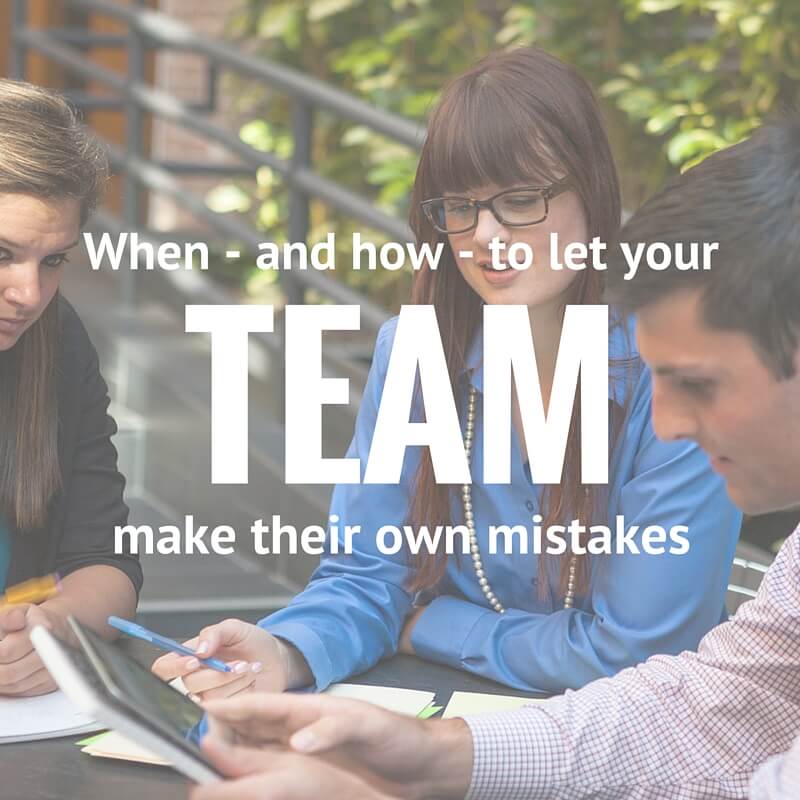When—and how—to let your team make their own mistakes
I have two daughters in college. For each of them, their first choice college was different from the school I thought would be best for them. They were both able to articulate to me why they were in favor of their first choice, but I still disagreed. This is a big decision; there’s a lot of money involved, and the ramifications could potentially influence the rest of their lives. How much influence should I exert? Whose decision should win?
One of my team members, who’s young, but smart and capable, comes to me with an approach and plan to deal with an issue that a client assigned to us. I can see the reasoning, but I favor a different approach. It’s not that I think that his approach will fail; it’s just that I’m more confident in my approach. Should I force my way, or yield to his suggestion?
I find myself thinking about these issues more frequently these days; in part because my children are getting older, more capable, and more independent. My team is also getting more experienced; and I recognize that they also came in with different experience (because of their age or exposure to different industries). As the age and experience gap between me and my team members grows, I find team members suggesting approaches, or tools, that I might not consider, or that I would discount altogether. Because the experience that they are bringing to bear on issues we are faced with is significantly different, they bring different opinions and suggestions to the table.
There could be value in those opinions and suggestions and—I don’t want to miss that! But I’m not sure…so the first thing I want to do is have a dialog. “What are you seeing that makes this your favored approach?” I’ll listen. Then I’ll share what I see that informs my opinion. Our goal here is to come to agreement, so we need to start by working with the same information, and identifying “What are we seeing differently that is leading us to different conclusions?”
Sometimes just having that conversation resolves things; I’m able to share something from my experience that they weren’t aware of, or they are able to inform me about some aspect of the issue that I wasn’t clear on. If so, great, problem solved. The issue is when discussion fails to change either of our perspectives (or changes them but still does not align them). Now what?

How do I know when to “let go”?
If we’ve reached an impasse (or if not an impasse then a difference of opinion), I want to start asking myself some questions:
1. What is the consequence of getting this wrong?
The most important issue here is how big a risk are we taking? If the team member’s opinion is mostly, or very similar to mine, and the differences are small and therefore unlikely to dramatically shift the outcome—fine. I will take a small risk and defer to my team member. If, on the other hand, I feel that his approach is more likely to produce a bad outcome, I’m going to push for doing it my way.
Big consequences mean I’m going to be more conservative and trust the more experienced person’s opinion.
2. What is the possibility that they are right?
On the other hand, I have to consider the possibility that they are right and I am wrong. Often times—if I try to actually take on the other person’s point of view—I can see the potential for a greater outcome than I might get with my proposal. And this is in spite of the risks I’m aware of. Is that upside worth the risk?
Then I have more work to do. I want to try to imagine the outcome that would demonstrate that their suggestion is the right one. Then I need to answer the question, “What has to happen in order for that outcome to be a reality? How likely is it that those things will happen? Is the result I can imagine as good as, or better than the result my approach will likely produce?”. Looking at it from the perspective that their approach will be successful often uncovers new insights for me.
3. How can we test each hypothesis?
Sometimes there are ways we can test different approaches. We can do one interview my way, and one another way, and compare the results! We could present both approaches, with their risks and opportunities, to the client and let them weigh in with their opinion. When there is a low-cost way to get more data, then let’s do that!
4. Who has to live with the consequences?
When we can try it their way and also try it my way—with low risks and low costs—I often let them try both. Or, we can try their way with the caveat that if the results aren’t satisfactory, they will go back and try it my way. This sort of exploratory stance may take more time—but it also produces more commitment. And it is a far better teaching tool (for both of us) than just going back and forth in discussion. When they get to have the experience of doing it both ways, they can get a better “feel” for why I made the suggestion that I did; or we both find out that their way was better. But we hedge the risk by having a backup plan.
Ultimately, we need to give our team members (and our children) the opportunity to make their own mistakes. I’m always trying to give them those chances without introducing any “risk of loss”; but that’s not always possible. Learning to ride a bike usually involves some scraped knees; and learning to lead a project or a team usually involves some mistakes along the way. In both situations, the learning and the experience is worth it in the long run.
Are you wondering about how my daughters’ college decisions played out? Well, after hearing me out, they dismissed my advice; and they each went to the schools that they felt were right for them. I didn’t argue. Neither choice was wrong. They both went to fantastic schools; just not the ones I would have picked for them. So far, it looks like they were right and I was wrong. Both of them are very happy and wouldn’t give my first choice schools a second look. All in all, I’d say that’s a good thing.

Could your leadership range restrain
the growth of your business?
Take our self-leadership assessment to identify opportunities
to grow your leadership (which could grow your business).
Get your results instantly without entering your email address.